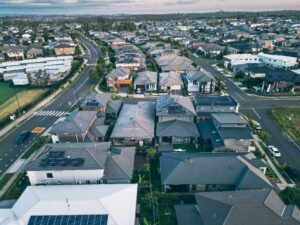Dominos Pizza Enterprises (ASX:DMP): FY25 was another year of the ship sinking further, but is there any hope for FY26?

Dominos Pizza Enterprises (ASX:DMP) is now less than 10% of what it was in mid-2021 – how can this be when fast-food stocks are meant to be recession proof and immune to inflation?
The company’s share price was inflated during the pandemic as locked down consumers ordered pizza at home. As restaurants opened again and interest rates rose to combat inflation, Dominos faced more intense competition, higher input costs and experienced more difficulty in generating returns from the investments made in its further growth.
To answer the question in this article’s title, FY26 could well be more of the same. But even if it is the year things turn around, investors will want to see concrete evidence it is happening. At <$2bn, it is now just a third of what gold developer De Grey was bought at despite it being several months away from production.
How did it come to this?
What are the Best stocks to invest in right now?
Check our buy/sell stock tips

Meet Dominos Pizza Enterprises
The Dominos Pizza Enterprises listed on the ASX is not the Domino’s parent company, but the master franchisor of Dominos in roughly a dozen countries: Australia, New Zealand, France, Germany, the Netherlands, Belgium, Luxembourg, Taiwan, Japan, Malaysia, Singapore and Cambodia. The irony is that this company services a population larger than the USA, with 418m people all up.
The company has been honest that it has penetrated just about all the market it can penetrate in Australia and New Zealand. It has been big on France and Japan as growth opportunities, as well as Taiwan.
Dominos franchises its stores to franchisees who run the stores and pay the day-to-day costs. Dominos earns 7% of gross sales in royalties and a further percentage (of up to 6%) towards national advertising. Dominos pays a royalty to the parent company in the USA of 2-3% of sales, subject to market conditions.
Dominos had a lot of things going for it, but inflation sent the company into terminal decline
For some years, we had a soft spot for this company. We liked the long-term leadership it had for over 20 years under Don Meji, established market position in many jurisdictions, its delivery capabilities proven during the pandemic, the propensity of fast food stocks generally to be good performers during tough economic times and the growth potential ahead of the company.
Dominos has a goal to have 7,100 stores by 2033, more than double the current number. Or at least, it did until it abandoned that goal because growth in Asia (where this was going to come from). The bulk of this was expected come from Asia – particularly Japan. But the company has been through difficult times.
But as people remerged form their cocoons, inflation skyrocketed and Dominos saw sales flatline as people pivoted to cheaper options. High inflation on ingredients and unfavourable forex movements compounded the hit to the company’s bottom line. To say the last quartet of years has been ugly for the share price is an understatement. Investors weren’t into growth stocks as they used to be…or at least growth stocks not seeing a return on the investments they were making.
Dominos tried rising prices only to see demand drop. Then it pivoted to offering ‘value’ with offerings like its $10 value box. In particular, it launched the My Domino’s Box that offers a pizza and 2 sides for A$10 each. And after such a long time of resisting partnering with third party delivery apps, head office decided to give in and embrace them. But it was making less money from more people.
Moreover, DMP was seeing increased competition from other fast food companies like Guzman y Gomez as well as rival Pizza Hut. The latter company’s operations were bought by California’s Flynn Restaurant Group in mid-2023 and while it doesn’t have to formally report figures, outgoing President of Flynn ANZ Phil Reed said on LinkedIn when he resigned that Pizza Hut had ’24 consecutive quarters of positive sales growth’.
The fall is complete…or is it?
In FY21, it made a $184m profit off $2.2bn revenue, derived from $3.7bn network sales $2.9bn of which were online sales). In FY24, it actually made higher network sales, $4.15bn but this is only because it has a higher store footprint than four years ago. Its revenue was $2.3bn, again higher, but it was $73m lower than the year before and the first time in 20 years revenue went backwards. Its sales in Europe were up 0.3%, but sales in ANZ were down 2.5% and sales in Asia retreated 7%.
Underlying EBITDA retreated from $362.7m to $346.7m, net operating cash flow fell by $70m to $167.2m. Its underlying profit was only $5m lower than the year before, at $116m but this is a far lower margin than during the pandemic. Its statutory profit was not a profit at all, but a $3.7m loss and its EPS was $1.263 per share. It paid 77c per share as a dividend, down from $1.06 the year prior.
If nothing else, it missed consensus estimates for the 9th reporting period running. But that is arguably the least of investors’ concerns.
A better future?
Don Meij left after 22 years and arguably stayed too long. He started at the bottom as a deliverer for Silvio’s Dial-a-Pizza, and within 6 years becoming an operational executive. When Silivos bought Dominos in 1993, Meij became General Manager but continued to work on the front line, becoming a franchisee in 1996. In 2001, he and another franchisee merged their stores into the Dominos corporate store network in return for a 20% stake in the company. He became CEO in 2002 and the growth continued, doubling sales between then and its 2005 IPO.
However, no CEO stays in place forever, and the longer they stay, the easier it is to say that a stagnating company can change as soon as its boss departs. Meij began to come under criticism as sales stagnated post-COVID. Scruitany around some of his property transactions (or a lack thereof) added up too. There were also eyebrows raised when his sister Kerri Hayman became ANZ head for the brain. To be fair, she had a Dominos career in her own right, including as operations director in the UK and a franchisee in the US.
His anointed successor was Mark van Dyck, a one time executive of food services company Compass Group. But he lasted less than a year and Chairman Jack Cowin now runs the company day to day and owns over 25% of the company. He claimed there were plans to turn things around, but investors have heard the same thing over and over and nothing seems to be working.
This year, the promise was that the company would drop its discounts (which had apparently trained customers to only buy when specials were on offer like on Tuesdays when pizzas were 50% off) and focus on delivering lower prices ordinarily. Cowin specifically named Bunnings’ ‘everyday low pricing model’ as what he would strive to emulate. He went so far as to say,’ We will tolerate a reduction in sales if it is profitable’.
He also claimed IT savings would help too and there would be specific strategies in France and Japan. The fact that same-store sales for the first 7 weeks of the financial year retreated by 0.9% didn’t bode well. It has also told investors it would continue to close unprofitable stores, but this is what it has promised time and time again and the results are yet to be seen.

Source: @mondyinvest/x
What is next?
Dominos has not given specific revenue or earnings guidance for the future, and how can it, to be fair? But it cannot avoid missing consensus estimates which call for flat revenue $2.3bn although $19m better EBITDA, $365.2m. It expects the bottom line to return to positive territory, but <10% growth from the underlying profit in FY25 – $126m to be exact.
In FY27, they call for $2.4bn revenue, $391.3m EBITDA and $1.60 EPS (a ~$150m profit). Then in FY28, $2.6bn revenue, $449.5m EBITDA and $2.01 EPS (a $190m profit roughly). Analysts’ mean target price is $24.19, 50% upside from the current share price, but well below COVID levels. The company is 14.2x P/E and 8.6x EV/EBITDA for the year ahead – sounds good, until you hear its PEG multiple…3.01x.
Still upside, but a lot less than before
As with all stocks, it is hard to argue Dominos won’t create shareholder value if it can capitalise on its plans successfully. But it has tried and failed multiple times before since the pandemic. To buy any company is to take a gamble that it will all go well. For our part, we would like to see more evidence the company is turning around before taking the plunge – preferably in either a set of half-yearly or yearly results.
And of course, investors need to realise that the days of the pandemic, with high-margins and people stuck at home eating pizzas are gone. The fast food sector is a fiercely competitive, low-margin business whatever companies may tell you otherwise. We think there are better opportunities for investors at this point in time.
Blog Categories
Get Our Top 5 ASX Stocks for FY26
Recent Posts
Diversifying Portfolios with ASX Consumer Stocks: Opportunities and Risks
The ASX 200 has delivered significant volatility recently, and market participants observing the screens in 2025 understand the turbulence firsthand.…
Is Lendlease (ASX:LLC) out of the doldrums for good?
Lendlease (ASX:LLC) has for the past several years been the classic definition of a ‘value trap’. You think a good…
Here are the 2 most important stock market taxes that investors need to be aware on
As one of two certainties in life, investors need to be aware of stock market taxes. Investors may be liable…


